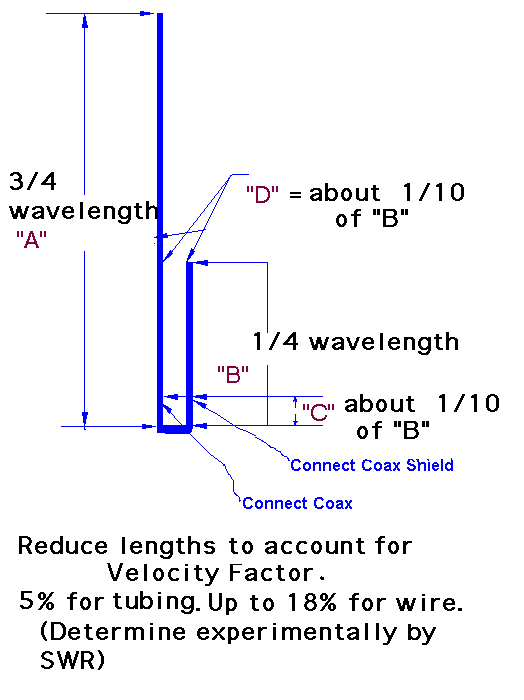
J-pole dimensions
The "Ugly MacGyver" 6 meter J-pole
The need
So what do you do when a strong wind storm finally topples your nice Diamond GH-6 5/8 wave 6 meter antenna and you want to check into the 6 meter net the next day? Quick repairs to the Diamond were out of the question. The top half of the vertical antenna was barely hanging on horizontally by a short wrinkled piece of copper wire that had been the matching coil.
What could I fix or build quickly that could get me back on the air? Since the antenna needed to be vertically polarized, I hit upon the notion of a J-pole. I had never built a J-pole before. With a little help from Google images for "J-pole" and "6 meter", I found several on-line calculators for the dimensions. Essentially, a J-pole is a 1/2 wave resonant antenna connected to a quarter wave matching stub. The feedline is connected at a point on the matching stub that is at the feedline's characteristic impedance. The result is 3/4 of a wavelength on one side and 1/4 wavelength on the other side. Those lengths must be reduced to account for the velocity factor of the antenna material, about 5% for copper or aluminum tubing and a somewhat greater percent for wire. My target frequency was 50.4 MHz. I needed to start with a 3/4 wavelength section that measuring 14 feet assuming just a 5% reduction for velocity factor.

A MacGyver solution
This was to be a temporary "MacGyver style" solution using only material I had available. I wanted cheap but workable. The antenna would be made of wire which I already had, not expensive copper pipe. The problem with using wire is needing something to hold the lower "J" portion of the antenna rigid. According to the dimensions I calculated, the rigid piece of insulator had to be at least 5 or 6 inches wide and about five feet long. What could I use that I had on hand that would be an insulator, that would be rigid enough, be easy to work with but not overly heavy? I thought about using a wooden plank or a thin piece of plywood but then came across upon a better and cheaper solution, a piece of left-over vinyl siding from my garage siding project. All I needed was about a 5 or 6 feet length. The bottom of the vinyl could be used with nylon ties as strain-relief to support a 5 turn 5 inch diameter coax RF choke and coax lead-in.

I found a piece of siding that was just about right. Since I was in a hurry, I didn't bother to trim it or even clean it. Therefore it is still "Ugly". I drilled some holes so I could thread the wire through the vinyl. The upper part of the wire was simply tied to a length of nylon rope with nylon ties. Since this was my first attempt at one of these, I foolishly soldered a length of coax at the dimensions suggested by the calculations (about 5 1/2 inches from the bottom of the "J".) I tested the result by hanging it just a few feet off the ground. Using my MFJ-209 HF/VHF SWR Analyzer and a handy frequency counter, I found the resulting J-pole to be resonant with lowest SWR at 49 MHz. I cut a total of about 6 or 7 inches off the longest dimension and gradually brought the resonant point close to the target of 50.4 MHz. That worked out to about a 10% reduction in length for velocity factor for the wire I used. After getting below an SWR of about 1.4, I decided to leave well enough alone for my first attempt at a J-pole and hoisted the antenna up a nearby pine tree. Reports from the net indicated that my signal strength was about the same as with the Diamond 5/8.
I have since learned that the J-pole is really just a vertical version of a Zepp, a half wave antenna connected to a quarter wave matching section. J-pole antennas are said to have greater low-angle radiation and gain versus a half-wave dipole. Claims of gain from 1 to 5 dB are seen in write-ups, but are not substantiated by sophisticated measurement and good theory.Neverteless, it makes a great antenna for emergency or on the cheap. MacGyver would be pleased with its "found-material" construction.
I have also learned that the dimension for the width of the J section is not all that critical. A three inch width should work as well. Such a narrower width requires that the feed point to maintain the 50 ohm impedance be raised a bit. My next version will likely be made up of a narrower strip of flat vinyl cut from a piece of siding so that the result can be rolled up for easy portability.
And how did I get it up that tree? I used a pint-size plastic bottle of water about half full tied onto twine. Just a couple of attempts were necessary before slinging the bottle over one of the highest branches.
Update
After the initial use of the J-pole, I received signal reports from some of the 6 meter net participants asking what I had done to boost my signal. Yes, the J-pole was apparently outperforming the old antenna, at least in their direction. That eliminated any incentive to stop using it. I continue to use the J-pole.
3-09 update 9-09